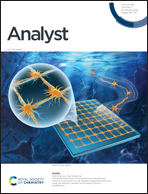Colorimetric discrimination of nucleoside phosphates based on catalytic signal amplification strategy and its application to related enzyme assays†
Abstract
Selective detection of adenosine monophosphate (AMP) and adenosine diphosphate (ADP) which are less charged molecules than adenosine triphosphate (ATP) or pyrophosphate (PPi) in aqueous solution has been considered challenging because AMP and ADP have relatively low binding affinity for phosphate receptors. In this study, colorimetric discrimination of nucleoside phosphates was achieved based on catalytic signal amplification through the activation of artificial peroxidase. This method showed high selectivity for AMP and ADP over ATP and PPi, unlike previous phosphate sensors that use Zn2+-dipicolylamine-based receptors. High selectivity of the suggested method allowed discrimination of AMP in aqueous solution by the naked eye, and the detection limit was estimated to be 0.5 μM. Mechanism analysis revealed AMP acted as activators in the peroxidation cycle of the Mn2(bpmp)/ABTS/H2O2 system despite having relatively low binding affinity. Additionally, high selectivity and quantitative signal amplification allowed for the development of colorimetric phosphodiesterase and a small molecule kinase assay method. The newly proposed method offers direct, real-time, and quantitative analysis of enzyme activities and inhibition, and is expected to be further applied to high-throughput screening of inhibitors.



 Please wait while we load your content...
Please wait while we load your content...